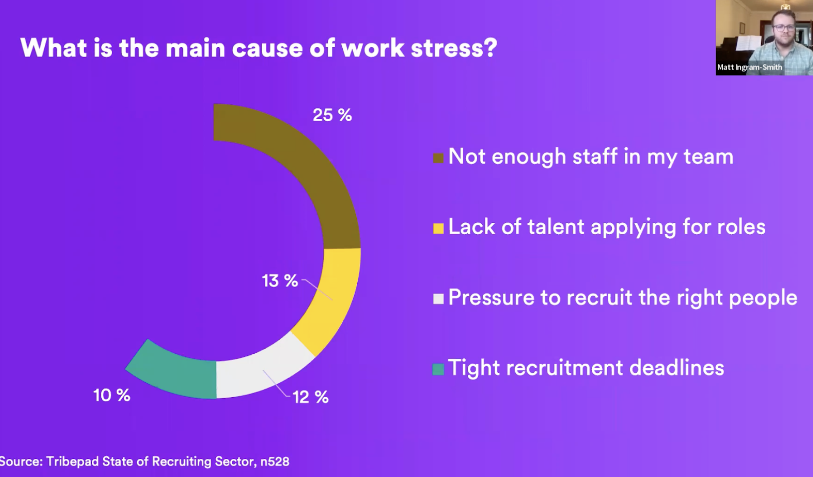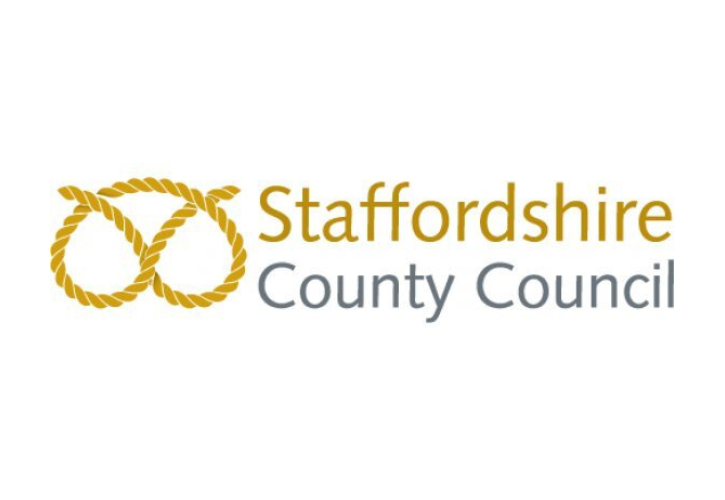Public sector recruiters are under enormous stress, exacerbated because upwards stakeholders often under-assign resource (Time! Money! Team members!).
Here are 6 tactics to modernise recruitment, transform the value you bring to the business, and make sure stakeholders know exactly what you’re worth.
Being a recruiter is bloody hard work. And it often feels like it’s getting bloodier and harder.
Our research last year found that 72% of people finders are experiencing stress at work – and more than a third are struggling to cope or at breaking point. (Download our State of the Sector report here, if you missed it).
When we dug into the main causes of this workplace stress, we found an interesting thing: three quarters of the major drivers for stress are internal. Look:

Not enough staff. Pressure. Tight deadlines. All clues that suggest there’s a chasm between what frontline people finders do, and what senior teams and business leaders understand or appreciate that you do.
Our findings apply to both the private sector and public sector but from the folks we chat to daily, we know this conversation is especially relevant for public sector organisations.
Time and budget pressure are a fact of public sector life – but these pressures are exacerbated because teams often struggle to showcase their full value. As a result, recruitment is often seen as cost centre (when you’re anything but) and already-tight purse strings are pulled tighter.
Let’s talk about changing that, to build better relationships with internal stakeholders and relieve some of the pressure making your team’s lives harder.
6 keys to modernising public sector recruitment
1. Set better objectives
Focussed objectives can feel like a luxury when you’ve got a billion-and-one things to do. Not to mention the endless bureaucracy you’re battling, and the various KPIs and SLAs trickled down from the top.
But taking time to reset and work out exactly what you want to achieve is the starting point for recruitment transformation. Good objectives are crucial to build your team’s credibility with senior leaders, because:
- They show the value you’re planning to offer
- They position your team more proactively and strategically
- They align your goals with the organisation’s goals
- They bring focus so you’re more likely to achieve impact
Gillian Davies, HR Resourcing Manager at Milton Keynes Council, spoke to The PPMA about how critical clear goal setting was while evolving the council’s recruitment function last year:
“There are an awful lot of systems out there that promise an awful lot. At the outset, we came up with a very tight spec of what we wanted and needed. That’s the advice I’d give anyone going through this process: be very clear with what you want to achieve.”
Gillie is talking there in the context of researching recruitment software but the same principle applies to specific projects and business-as-usual recruitment. Take the time upfront to outline what you can realistically achieve and the resources you’ll need to get there.
That’s a much more compelling case for credibility and investment than taking orders. (Of course, you now have to deliver on those expectations!).
2. Focus on EVP and CX
You won’t be surprised that one of the biggest causes of stress for recruiters is the lack of available talent. Especially in the public sector, where you’re usually fighting big battles around salary, benefits, and flexibility.
Talent shortages hurt recruitment delivery, which in turn hurts recruitment’s credibility, causing more stress as teams are denied resources and put under even more pressure. In other words, addressing shortages is HUGE.
Although there are wider dynamics going on, like skills shortages and an aging workforce, there’s still lots recruitment teams can do. It really comes down to how you attract and search for talent, to widen the funnel of candidates entering your process.
Public sector recruitment teams can often learn lessons from the private sector here. Signature Healthcare is a great example, who increased monthly applications from about 900 to 16,000 by actively designing a great candidate experience that surfaced their EVP.
(Matt talks you through this in more detail in our recent webinar with the PPMA).
3. Improve talent pooling
Our research shows that around 50% of recruiters are dissatisfied with their roles because they’re seen by stakeholders as order-takers. This reactive approach to recruitment causes stress and hurts delivery because you’re endlessly running from priority to priority, without the headspace to work smarter.
Talent pooling is a critical tactic for recruitment teams to become more proactive and stop the stress cycle.
Building, engaging, and nurturing talent pools of great pre-screened candidates means you set up your future self to win. Ultimately shortening time-to-hire, improving fill-rates, and boosting quality-of-hire.
If your organisation has slowed or frozen hiring as financial pressure continues, now is an especially great time to focus on building these processes. They’ll pay dividends later.
4. Create better ways to collaborate
Not having the right people in your team is a major cause of stress, as public sector recruitment teams face constant pressure to do more with less. That puts a higher premium on good collaboration, because every contributor to your process counts.
Hiring managers can be either a powerful extension to your talent team, or another hurdle that slows progress.
One thing we’ve seen among the most successful recruitment teams is a mindset shift among hiring managers. In these teams, hiring managers embrace recruitment as a small but essential part of their day – rather than a chore or bore.
That shift has only been able to happen because hiring managers are empowered with the right tools to act fast, on the go.
And with managers contributing to a better, faster recruitment process, delivery is better. So managers see the benefits immediately, with fewer empty seats, less time training, more prepared new starters, fewer drop-outs, and happier teams.
Richmond & Wandsworth Councils are a fantastic example. Simon Pollen, Strategic Resourcing and Talent Acquisition Manager talks about how creating internal stakeholder engagement through the right education, processes, and tech has been central to evolving their recruitment.
5. ED&I
Diversity has a massive impact on company culture and business outcomes across every customer we work with, and recruiters play an instrumental role. After all, diversity is a reality but inclusion is a choice.
Delivering better diversity outcomes should be a major focus for recruitment teams, to prove value against a major C-suite priority. (As well as for its own sake, because building fair, equitable processes is the right thing to do.)
Among public sector recruiters, we see a real variance depending on the tech you use (and the processes that tech enables).
There’s no silver bullet for diversity and inclusion but the right software should help you make little changes to get gradually fairer and more inclusive, to improve representation for the communities you serve.
Read more: Step-by-step how local authorities can make progress on ED&I
For example: we pulled the numbers for eight local government organisations we’re working with and found an average of 18% increase in applications from candidates from diverse ethnic backgrounds since using Tribepad.
6. Reporting and analytics
Few people get out of bed for reporting, we know that. But better recruitment reporting empowers you to tell better stories, to better showcase your value upwards.
This stuff really matters but it’s often an area where teams have room to improve.
For HR leaders, knowing the hard numbers means you can spot opportunities to optimise or improve – for example, reallocating budget into channels that produce your best source of hire or repeating your top-performing recruitment campaigns.
For business leaders, having the hard numbers around, say, recruitment ROI means you can instantly communicate your value in a compelling way.
In the public sector, spend will always be highly scrutinised. Public sector recruiters can make their lives much easier by getting ahead of those demands, with regular, clear, simple reporting.
You can’t pour from an empty cup…
… or please put your own oxygen mask on first, as the plane announcement goes.
Recruiters, resourcers, talent acquisition professionals – people finders of all types – in the public sector are under an extraordinary amount of pressure. Sometimes it probably feels like the weight of the organisation and the weight of your community is on your shoulders.
You can’t carry that weight without the support, understanding, breathing space, and investment to modernise recruitment. These six pointers should help you start to shift perspectives around recruitment and forge better relationships with stakeholders.
–
Tribepad is the trusted tech ally to smart(er) recruiters everywhere. Combining ATS, CRM, Video Interviewing, and Onboarding, our talent acquisition software is a springboard for faster, fairer, better recruitment for everyone.
Trusted by the NHS, BBC and numerous local authorities including Coventry City Council, Surrey County Council, and Kent County Council, 25 million people in 16 languages use Tribepad.
Download our buyer’s guide for recruitment software in the public sector to unpack how modern tech can help your organisation grow.






